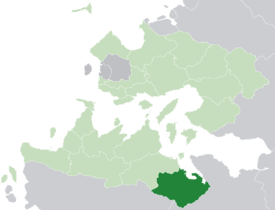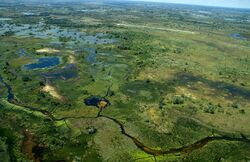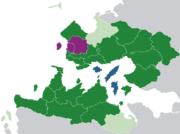Txekrikar
Principality of Txekrikar Ivezhqoi Txekrimíso | |
|---|---|
|
Flag | |
 Location of Txekrikar (dark green) in the Trellinese Empire (light green) | |
| Status | Nation of the Trellinese Empire |
| Capital and largest city | Onostada |
| Official languages | Sa'sseban, Trellinese |
| Ethnic groups (2013) | 89.1% Txekri 4.5% Velaric 3.1% Trellinese |
| Demonym(s) | Txekri |
| Government | Unitary parliamentary constitutional principality |
• Prince | Eshkan ha'Roita |
• Protector | Azara V |
| Establishment | |
• Principality | 642 |
• Coalition of the East | 976 |
• Client of the Trellinese Empire | 1907 |
• Reunification | 1938 |
• Entry into the empire | 1963 |
| Area | |
• Total | 128,424.8 km2 (49,585.1 sq mi) |
| Population | |
• 2013 census | 8,149,016 |
• Density | 63.45/km2 (164.3/sq mi) |
| Gini (2012) | 30.1 medium |
| HDI (2011) | 0.847 very high |
| Currency | Rasna (Ʀ) (TRS) |
| Time zone | (UTC) |
| Date format | dd/mm/yyyy |
| Driving side | left |
| Calling code | +87554 |
| Internet TLD | .tx |
Txekrikar, officially the Principality of Txekrikar (Sa'sseban: Ivezhqoi Txekrimíso; Trellinese: Lametha Txekrikarqa) is a protectorate and nation of the Trellinese Empire on the Astyrian continent of Teudallum. It borders Andamonia to the east, the Aztec National League to the south, the Trellinese province of Ternos to the west and the Sea of Velar to the north. With a landmass of 128,425 square kilometres it is the sixth-largest province-level administrative region by area in the empire, and its population of 8,149,016 makes it the thirteenth-most populous.
Txekrikar is governed by a constitutional monarchy under the ha'Roita dynasty. Its capital and largest city is Onostada, near the northwest of the coast. The prince, since 1998, is Eshkan ha'Roita. As a protectorate of the Trellinese Empire, it also recognises the sovereignty of the King of Trellin, currently Queen Azara V.
In the middle ages, Txekrikar was an influential state in Velaran politics. From the end of the tenth to the end of the fifteenth centuries it was a member of the Coalition of the East, with the nation of Ja'ekha, among others, which sought to restrict the expansion of the Kingdom of the Isles of Velar. It also spent several centuries attempting to conquer western Andamonia. It entered decline in the sixteenth century as trade shifted out of the Sea of Velar, and its colonial growth was restricted to the empty grasslands of Ternos, which provided expansive pastures. Txekrikar's ruling house arrived from western Andamonia in the early eighteenth century, fleeing persecution by its rivals.
From 1872 to 1875 Txekrikar fought against Andamonia, a war which ended in a stalemate but left a second war inevitable. This erupted in 1920 and became part of the Great Astyrian War, which Txekrikar ultimately lost and which saw the annexation of the country's eastern territory, the Usmalím. In 1907, it became a client of the Trellinese Empire. During the Trophy Wars, Txekrikar was one of the most active theatres and its landscape was scarred by incessant conflict. Trellinese and Txekri forces ultimately drove the Andamonian occupying force out of the western Usmalím. It has been a constituent nation of the Trellinese Empire since 1963, the twenty-fifth anniversary of the country's partial reunification.
The War of the Eastern Velar, fought in late 2014, brought intense conflict back to eastern Txekrikar as Andamonia invaded the western Usmalím. After Andamonia's surrender, its emperor agreed to a transitional government to oversee the return of the Andamonian Usmalím to Txekrikar. The two halves of the territory were formally unified in early 2016.
Etymology
The name Txekrikar was first introduced to English from Trellinese. It is a contracted form of Txekriq akarë, "Txekri land." This is the name most commonly transliterated in other languages. The native name for the state, Ivezhqoi Txekrimíso, means "Txekrian Principality;" no short form is prescribed, although Txekria is sometimes used as a back-formation from "Txekrian," a term which is usually restricted to a purely geographic usage.
History
Prehistory and early history
Middle ages
Early modern
Modern era

In the 1871 Andamonian presidential election, candidate Muriaz Raihanri captured popular favour when he promised a short and successful war against Txekrikar. Once elected, he proved hesitant in declaring war, and ultimately it was the provocation of his government that led Txekrikar to declare war on Andamonia instead. The resulting engagement was fought between 1872 and 1875 and came to be known as the Baira Debacle as, despite impressive initial gains by Andamonian forces and major engagements such as the Siege of Belziroa, it ended with a return to the status quo. This conflict set the scene for a future war between the two nations.
In anticipation of this war, Txekrikar petitioned the Trellinese monarchy to be admitted as a client state in 1891. Its application was set aside during the Trellinese Civil War, during which time Txekrikar's prince lent support to King Hasper. Despite this support, Hasper did not pick up the application again, and the principality only achieved protectorate status in 1907 under King Amadar IV. The following years saw a blossoming of Txekri trade with Trellin and its sphere, and there was particularly an influx of industrial investment from Arimathea and Kur'zhet. When Trellin entered isolation in 1913, it set back Txekri economic growth and renewed concerns that Trellin might not be able to protect the principality from Andamonian attacks. The military turned to Arimathea to update its arsenals, including purchasing five Tasarin-class dreadnoughts from Alukiri and Malle.
Great Astyrian War
Trophy Wars
Geography
Txekrikar is bounded by Trellin proper, the Aztec National League, Andamonia and the Sea of Velar. Its western borders are predominantly defined by rivers, with the Baira forming much of its border with the Aztec National League and formerly the border with Andamonia. The country's topography is characterised by a broad plain which rises slightly towards the coast. Roughly 44,000 square kilometres, more than a third of the nation's land area, is designated as marshland.
Txekrikar lies between 4.5° and 8.2° south of the equator. Most of the country experiences a tropical or subtropical climate with high humidity year-round. Monsoons affect to the country between September and late November. The notable exception to this is the small portion of dry desert west of the town of Acanzia, in Mugan Prefecture. This is the easternmost arm of the Ternosi desert.
Politics
International relations
Military
Txekrikar's military is the Txekri Guard, which is independent of the Armed Forces of the Sidereal Crown despite their close ties. The prince of Txekrikar serves as its commander-in-chief.
Demographics
Largest cities or towns in Txekrikar
Statistical, Demographical and Census Department | |||||||||
|---|---|---|---|---|---|---|---|---|---|
| Rank | Prefecture | Pop. | |||||||
 Onostada  Iruska |
1 | Onostada | Kialeku | 954,273 |  Sasahiri  Zitiar | ||||
| 2 | Iruska | Arrain | 887,352 | ||||||
| 3 | Sasahiri | Barre | 804,148 | ||||||
| 4 | Zitiar | Usmalím | 513,487 | ||||||
| 5 | Belatxia | Lurak | 388,211 | ||||||
| 6 | Tibiso | Kialeku | 374,864 | ||||||
| 7 | Resiark | Arrain | 312,736 | ||||||
| 8 | Unya | Mugan | 248,519 | ||||||
| 9 | Pezaldi | Barre | 231,597 | ||||||
| 10 | Behiria | Kialeku | 164,051 | ||||||




